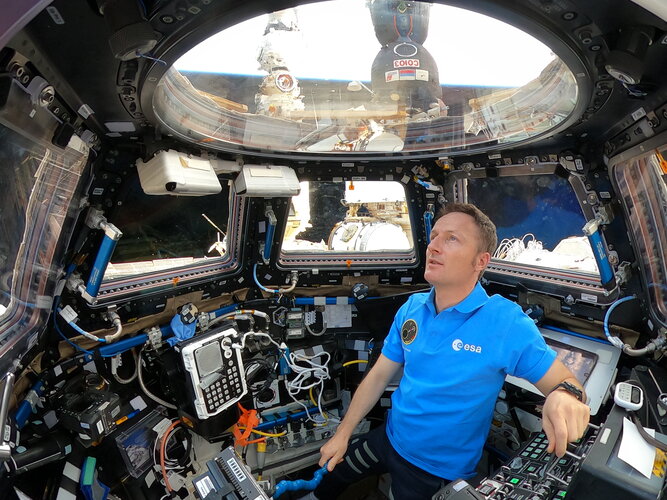
Copernical Team
Week in images: 21 - 25 February 2022

Week in images: 21 - 25 February 2022
Discover our week through the lens
100
 Image:
Image:
Happy 100 days in space to ESA astronaut Matthias Maurer. The first-time space flier marked the milestone on 19 February 2022 and what a busy 100-days it been.
In a Twitter post marking the milestone, Matthias wrote, “100 days may sound like a lot, but it feels like I've only just arrived.”
Even before launching for his Cosmic Kiss mission on a SpaceX Dragon as part of Crew-3, Matthias was on the science, providing researchers with pre-flight measurements for a variety of experiments.
Since arriving, Matthias has continued to be poked and prodded while working, exercising and even sleeping, all in
Cosmic flashes pinpointed to a surprising location in space
 Astronomers have been surprised by the closest source of the mysterious flashes in the sky known as fast radio bursts. Precision measurements with radio telescopes reveal that the bursts are made among old stars, and in a way that no one was expecting. The source of the flashes, in nearby spiral galaxy M 81, is the closest of its kind to Earth.?
Fast radio bursts are unpredictable, extreme
Astronomers have been surprised by the closest source of the mysterious flashes in the sky known as fast radio bursts. Precision measurements with radio telescopes reveal that the bursts are made among old stars, and in a way that no one was expecting. The source of the flashes, in nearby spiral galaxy M 81, is the closest of its kind to Earth.?
Fast radio bursts are unpredictable, extreme Ball Aerospace supports CDR of NASA's SPHEREx mission
 Ball Aerospace supported completion of critical design review (CDR) for NASA's Spectro-Photometer for the History of the Universe, Epoch of Reionization and Ices Explorer (SPHEREx) mission. Ball will now move forward with building the telescope and spacecraft.
In addition to designing and building the spacecraft and telescope, Ball Aerospace is responsible for conducting system integration
Ball Aerospace supported completion of critical design review (CDR) for NASA's Spectro-Photometer for the History of the Universe, Epoch of Reionization and Ices Explorer (SPHEREx) mission. Ball will now move forward with building the telescope and spacecraft.
In addition to designing and building the spacecraft and telescope, Ball Aerospace is responsible for conducting system integration Potential widespread effects of geoengineering on both climate and the carbon cycle
 Global warming poses a great threat to our society, and it will continue unless a deep and rapid reduction in greenhouse gas emissions is implemented. One alternative way to counteract some of the undesired effects of global warming is geoengineering, also referred to as solar radiation modification, or climate engineering.
The basic idea of geoengineering is to cool the earth by intention
Global warming poses a great threat to our society, and it will continue unless a deep and rapid reduction in greenhouse gas emissions is implemented. One alternative way to counteract some of the undesired effects of global warming is geoengineering, also referred to as solar radiation modification, or climate engineering.
The basic idea of geoengineering is to cool the earth by intention The last day of the dinosaurs
 The asteroid which killed nearly all of the dinosaurs struck Earth during springtime. This conclusion was drawn by an international team of researchers after having examined thin sections, high-resolution synchrotron X-ray scans, and carbon isotope records of the bones of fishes that died less than 60 minutes after the asteroid impacted. The team presents its findings in the journal Nature.
The asteroid which killed nearly all of the dinosaurs struck Earth during springtime. This conclusion was drawn by an international team of researchers after having examined thin sections, high-resolution synchrotron X-ray scans, and carbon isotope records of the bones of fishes that died less than 60 minutes after the asteroid impacted. The team presents its findings in the journal Nature. Space Micro lands Space Development Agency contract for optical communications
 Voyager Space and Space Micro has announced an award from the Space Development Agency (SDA) for a 24-month development contract for advanced one-to-many optical communications using Managed Optical Communication Array (MOCA) technology to support Low Earth Orbit (LEO) constellations. Space Micro partnered with BridgeComm Inc., a global leader in optical wireless communications solutions and ser
Voyager Space and Space Micro has announced an award from the Space Development Agency (SDA) for a 24-month development contract for advanced one-to-many optical communications using Managed Optical Communication Array (MOCA) technology to support Low Earth Orbit (LEO) constellations. Space Micro partnered with BridgeComm Inc., a global leader in optical wireless communications solutions and ser Pentagon and Partners Release Combined Space Operations Vision 2031
 The United States joins Australia, Canada, France, Germany, New Zealand, and the United Kingdom in the joint release of the "Combined Space Operations (CSpO) Vision 2031" today.
CSpO is an initiative to address the overarching need to encourage responsible use of space, recognizing challenges to space sustainability, threats presented by technological advances, and the increasingly compreh
The United States joins Australia, Canada, France, Germany, New Zealand, and the United Kingdom in the joint release of the "Combined Space Operations (CSpO) Vision 2031" today.
CSpO is an initiative to address the overarching need to encourage responsible use of space, recognizing challenges to space sustainability, threats presented by technological advances, and the increasingly compreh Earth from Space: Washington, US

To celebrate the recent data release from Landsat 9, this week we take a closer look at a part of Washington state – the northwesternmost state of the US – through the lens of Landsat 9.
Successful first year for UK-Australia Space Bridge
 This week marks the first anniversary of the Space Bridge between UK and Australia - a partnership focused on facilitating collaboration between the two countries' space sectors. A world first, the Space Bridge has unlocked improved access to trade, investment and academic research opportunities, better advice to businesses and innovative bilateral collaborations.
The arrangement enhances
This week marks the first anniversary of the Space Bridge between UK and Australia - a partnership focused on facilitating collaboration between the two countries' space sectors. A world first, the Space Bridge has unlocked improved access to trade, investment and academic research opportunities, better advice to businesses and innovative bilateral collaborations.
The arrangement enhances 
































